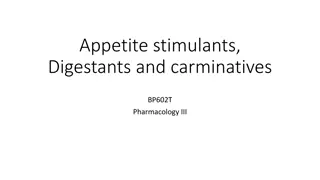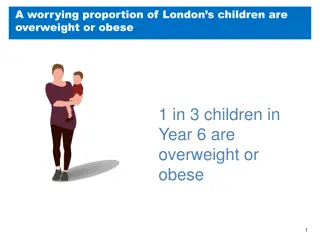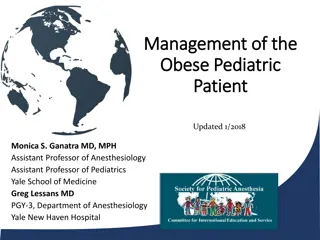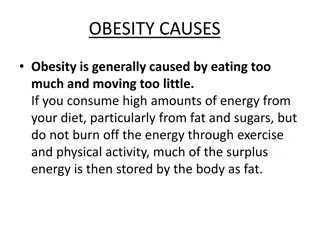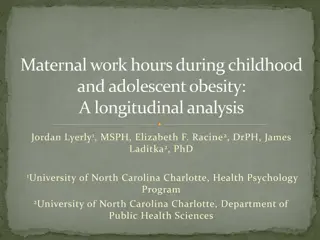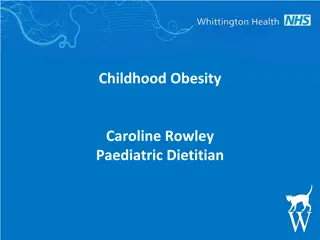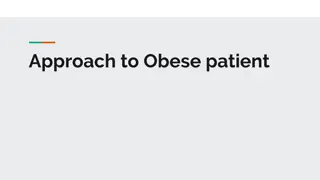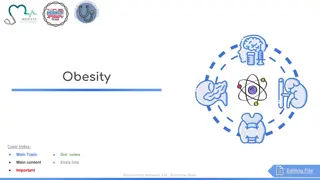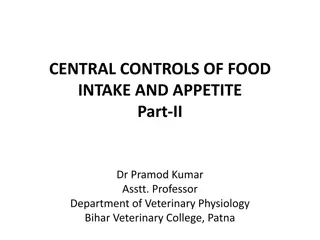Spinach in Diet for Obesity Control: Regulatory Action on Appetite
Spinach, scientifically known as Spinacia oleracea, has been highlighted as a beneficial addition to diets aimed at controlling obesity due to its regulatory effect on appetite. Dr. Vandana Panda, an Associate Professor of Pharmacology at P.K.M Kundnani College of Pharmacy, Mumbai University in India, emphasizes the importance of functional foods like spinach in maintaining energy homeostasis and preventing weight gain by influencing factors such as metabolic rate and physical activity. The interaction of nutrients and gastrointestinal peptide hormones plays a crucial role in both short-term and long-term satiety signaling, ultimately impacting body weight regulation. Incorporating fruits and vegetables rich in flavonoids, particularly spinach, into daily meals can aid in reducing weight gain and promoting satiety.
Download Presentation

Please find below an Image/Link to download the presentation.
The content on the website is provided AS IS for your information and personal use only. It may not be sold, licensed, or shared on other websites without obtaining consent from the author.If you encounter any issues during the download, it is possible that the publisher has removed the file from their server.
You are allowed to download the files provided on this website for personal or commercial use, subject to the condition that they are used lawfully. All files are the property of their respective owners.
The content on the website is provided AS IS for your information and personal use only. It may not be sold, licensed, or shared on other websites without obtaining consent from the author.
E N D
Presentation Transcript
Spinacia oleracea in diet can help control obesity by its regulatory action on appetite Dr. Vandana Panda Assoc. Professor of Pharmacology P.K.M.Kundnani College of Pharmacy Mumbai University, INDIA
"Let food be thy medicine and medicine be thy food," said by Hippocrates nearly 2,500 years ago, is receiving renewed interest. 2
Functional foods: Functional foods are foods which provide benefits beyond basic nutrition and may play a role in reducing or minimizing the risk of certain diseases and other health conditions. 3
Energy homeostasis is a complex mechanism which maintains body weight by regulating energy intake. Obesity occurs due to an imbalance in energy homeostasis. Four main predisposing factors for weight gain: a) low metabolic rate b) low spontaneous physical activity c) low sympathetic nervous system activity d) low fat oxidation
CENTRAL NERVOUS SYSTEM HYPOTHALAMUS NUCLEUS TRACTUS SOLITARIUS PARAVENTRICULAR NUCLEUS (PVN) APPETITE SATIETY POMC NPY/ AgRP VAGAL CENTRE ARCUATE NUCLEUS (ARC) PERIPHERAL ORGANS INSULIN & LEPTIN GHRELIN Signals from GIT, stomach distension, enterohormones- CCK, PYY, GLP-1 PANCREAS & ADIPOCYTES STOMACH LONG TERM SIGNALS SHORT TERM SIGNALS
Short term satiety signals: a. Nutrients b. Gastrointestinal peptide hormones Cholecystokinin(CCK), Glucagon like peptide -1 (GLP-1), peptide tyrosine tyrosine (Peptide YY) Long term satiety signals: a. Insulin(Pancreas) b. Leptin (Adipose tissue) c. Ghrelin ( stomach)
Background Fruits and vegetables which are rich in flavonoids particularly flavonols, anthocyanins and flavones are associated with reduced weight gain. Recent studies have shown thylakoids, the internal membranes of chloroplasts in green leafy vegetables to induce satiety. Spinacea oleracea known as spinach is a green leafy vegetable consumed by people across the globe in various tasty culinary preparations.
Spinach leaves are a rich source of flavonoids (rutin, spinacetin, patuletin, jaceidin and their 3 ,4 -trihydroxy-3-methoxy-6,7-methylene dioxy flavone-4 glucuronides), polyphenols, carotenoids (lutein, - carotene, chlorophyll), vitamins (A, B & folic acid, C and K) & minerals. It is reported to possess potent medicinal properties by virtue of its above mentioned antioxidant phytoconstituents, together termed as the natural antioxidant mixture (NAO).
Objective The objective of the work was to study whether spinach could curb food intake and reduce weight gain in rats by inducing satiety due to its high content of thylakoids and flavonols. The present study evaluates the effect of a flavonoid- rich extract of Spinacea oleracea on food intake, body weight and the short term satiety markers cholecystokinin and glucose.
Materials and Methods Preparation of Natural antioxidant (NAO) extract from spinach leaves: NAO extract stored in air tight container and used for experiment Soxhlet apparatus 10
HPTLC finger printing of NAOE NAOE (500 mg) was dissolved in 5 mL of methanol and was applied as a band of 8 mm length on the activated HPTLC plates using a Linomat 5 applicator (CAMAG, Switzerland). Class of the compound to be separated Amount of solution applied on plate Solvent system Derivatising agent Antioxidants 20 mL chloroform: toluene: ethanol (4: 4: 1) 0.1Mm DPPH in methanol Flavonoids 20 mL ethyl acetate: formic acid: glacial acetic acid: water (10: 0.5: 0.5: 1.3) 10% methanolic sulphuric acid Phenols 20 mL ethyl acetate: methyl ethyl ketone: formic acid: water (5:3:1:1) 10% methanolic sulphuric acid
HPTLC fingerprinting of NAOE for antioxidants HPTLC analysis showed clear separation of 13 antioxidants from NAOE (Figure 4.1). Rf values of the separated antioxidants were observed to be in the range of 0.02 to 0.93. 1 2 3 4 5 6 7 8 9 10 Chromatogram and Rf value for antioxidant compounds present in NAOE at 366 nm HPTLC finger printing of NAOE for antioxidants at 366 nm
HPTLC fingerprinting of NAOE for phenolic acids HPTLC analysis showed clear separation of 10 phenolic acids from NAOE (Figure 4.5). Rf values of the separated phenolic acids were observed to be in the range of 0.03 to 0.91. 1 2 3 4 5 6 7 8 9 10 Chromatogram and Rf value for phenolic acidspresent in NAOE at 366 nm HPTLC finger printing of NAOE for phenolic acid at 366 nm
HPTLC fingerprinting of NAOE for flavonoids HPTLC analysis showed clear separation of 14 flavonoids from NAOE (Figure 4.3). Rf values of the separated flavonoids were observed to be in the range of 0.03 to 0.93 1 2 3 4 5 6 7 8 9 10 HPTLC finger printing of NAOE for flavonoids at 366 nm Chromatogram and Rf value for flavonoids present in NAOE at 366 nm
HPTLC Chromatogram of standard rutin at 254 nm Rutin Peak Max Rf Area Area % 1 0.07 1139.7 100
HPTLC Chromatogram of flavonoids and rutin from NAOE at 254 nm Rutin Peak Max Rf Area Area % 1 0.01 190.1 5.47 2 0.02 329.6 9.49 3 0.07 727.6 20.95 4 0.09 878.4 25.29 5 0.13 1348.0 38.81
Quantity of rutin present in NAOE Sample Amount of NAOE ( g) Max Rf Peak area Rutin (%) NAOE (Peak 3, Figure 1c) 150 0.07 727.6 8.5 Standard rutin (Figure 1d) 20 0.07 1139.7 100
Evaluation of the satiating effect of NAOE GROUP TREATMENT DOSE DURATION GROUP I CONTROL DRINKING WATER 14 DAYS GROUP II REFERENCE STANDARD (FLUOXETINE) 6 mg/kg, ip. 14 DAYS GROUP III NAOE200 200 mg/kg p.o. 14 DAYS GROUP IV NAOE400 400 mg/kg p.o. 14 DAYS
Table 1. Effect of NAOE and fluoxetine on food intake TREATMENT GROUP FOOD INTAKE (g) Control 9.204 0.111 3.104 0.298***(66.27) Fluoxetine (6mg/kg) 5.795 0.279*** (37.03) NAOE200 NAOE400 5.714 0.249*** (37.92) All values are expressed as mean SEM; N = 6 in each group;One way ANOVA followed by Tukey-Krame rmultiple comparison test is applied for statistical analysis***P< 0.001when experimental groups compared with control group.
Table 2.Effect of NAOE and fluoxetine on reduction in weight gain Treatment Group % Reduction in weight gain Control 1.66 1.17 Fluoxetine (6 mg/kg) 11.32 2.36** NAOE200 7.96 1.94 NAOE400 10.05 1.76* All values are expressed as mean SEM; N = 6 in each group; One way ANOVA followed by Tukey-Kramer multiple comparison test is applied for statistical analysis *P< 0.05, **P< 0.01, when experimental groups compared with control group.
Effect of fluoxetine and NAOE on serum levels of CCK
Effect of NAOE and fluoxetine on plasma glucose levels 136 131 131 126 126 121 121 Glucose (mg/dL) Glucose (mg/dL) 116 Control control 116 fluoxetin fluoxetine 111 NAOE200 NAOE200 111 NAOE400 NAOE400 106 106 101 101 96 96 O min 30 min 60 min 180 min O min 30 min 60 min 180 min Time (min) Time (min) Effect of NOAE and fluoxetine on plasma glucose levels on 7th day Effect of NOAE and fluoxetine on plasma CCK levels on 14 th day
18 flavonoids representing glucuronides and acylated di and triglycosides of the 6-oxygenated flavonols (patuletin, spinacetin and jaceidin) have been identified from spinach by Howard et al, USA (Cho, Howard, Prior & Morelock, 2008). HPTLC of NAOE in present study could detect 14 flavonoids,13 antioxidants and 10 phenolic acids.
PVN Brain Mechanism of action of Fluoxetine on food intake ARC
Events in brain: Nerve signal -> POMC(NTS) ->Secretion of -MSH ->Activates MC4R Receptors on PVN -> Inhibition of orexigenic AgRP/NPY signals -> Satiety induced Mechanism of action of CCK on food intake Vagus nerve Activation of CCK1 Receptors due to CCK POMC- Pro-opiomelanocortin neurons. NTS- Nucleus Tractus Solitarius CCK- Cholecystokinin -MSH- - Melanocyte Stimulating Hormone PVN- Paraventricular Nucleus CCK released from enteroendocrine I- Cell of proximal small intestine after ingestion of food
14th Day 7th Day Control Peaking of CCK-60 min Reduced Food Intake and Weight gain Peaking of CCK-60 min Reduced Food Intake and Weight gain Peaking of CCK-30 min Reduced Food Intake and Weight gain Peaking of CCK-30 min Reduced Food Intake and Weight gain Fluoxetin Peaking of CCK-60 min Reduced Food Intake and Weight gain Peaking of CCK-60 min Reduced Food Intake and Weight gain NAOE200 Peaking of CCK-30 min Reduced Food Intake and Weight gain NAOE400 Peaking of CCK-60 min Reduced Food Intake and Weight gain
Our Team Ms. Priyanka Shinde & Dr. Vandana Panda Dept. of Pharmacology P. K. M. Kundnani College of Pharmacy Mumbai University India
THANK YOU !!! Stay Healthy, Stay Happy!!!! 29








